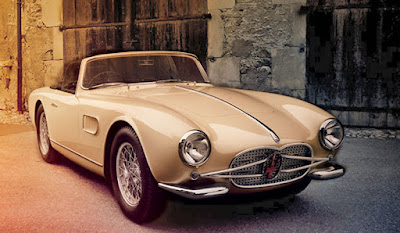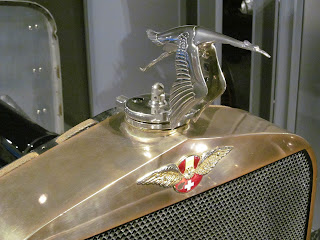Most people who like cars remember the four-cylinder Birdcage Maseratis from the late 50s and early 60s with their swoopy alloy body shells not quite hiding complex space frames of fragile-looking tubes. Even people who don't like cars (maybe especially those people) remember "Chrysler's TC by Maserati", a late 80s project cooked up by DeTomaso and Iacocca which was definitely not a Maserati*, but it seems only race fans or enthusiasts of a certain age remember the Maserati 150S and 200S. What all these cars had in common was a four-cylinder power unit with the Maserati name on it. Maserati was more famous for straight sixes and V8s, but had built engines in a wide (some would say wild) array of configurations, including a V16 in the 1930s, the straight 8 that won the Indy 500 twice, and the V12s that appeared in late versions of the 250F and also in mid-engined versions of the famous Birdcage and the 3 liter Cooper F1 car. Back in 1947, just as the Maserati brothers' 10 year consulting arrangement with the Orsi family (to whom they'd sold their car factory and name) was ending, Maserati introduced its first postwar A6 cars. These were powered by a single overhead cam inline six of 1.5 liters. For another decade, Maserati road cars held to the theme of getting performance from small displacements, with touring models never exceeding 2 liters. The four-cylinder cars, however, were an answer to road racing Ferraris of the era, like the 4 cylinder 500 Mondial, and to the successful OSCAs, which were built by the Maserati brothers after they left their namesake firm*. In 1955, the first 150S appeared with Bellantani-designed twin-cam aluminum 1.5 liter four, aimed directly at the OSCA MT4 1500 which had won the Sebring 12 hour race outright the previous year. Initially the car was raced with a live rear axle, but this was later replaced by a De Dion type. The early bodywork on the car below was by Fiandri, while later cars were built by Fantuzzi...
There was also a lone 150S spider from 1957 with full weather protection and bumpers, also bodied by Fantuzzi in a style reminiscent of Frua's contemporary Maseratis. The car was built on an A6GCS chassis, and only released by the factory after they'd decided to make the larger and more luxurious 3500GT their production car.
An earlier version of the car sported a cleaner, less orthodontal grille treatment...Around two dozen of the 150S were sold to customers between 1955 and 1957.
During the same years, Maserati offered a similar sports racer for the 2 liter class, with the twin-cam aluminum four employing dry sump lubrication and 2 spark plugs per cylinder to make a claimed 190 hp. As with the 150S, the fully developed racer substituted a De Dion rear suspension with transverse leaf spring for Maserati's trusty live axle, and front suspension was by coil springs. Bodywork suppliers were also shared with the 150S, with early bodies by Fiandri, and later ones, like Dennis Varni's 200SI from 1957 (the red car below) featuring bodywork by Fantuzzi.
The Varni example is actually a 200SI, with the "I" signifying International (no, not Harvester) and meaning that it was one of the series built to comply with then-new FIA racing regulations requiring full weather protection, full-width windshields, and bigger doors. Early versions of the 200S featured 4 speed gearboxes, while later ones were offered with 5 speeds.
Bodywork had a family resemblance to the legendary 300S road racers, also by Fantuzzi, especially at the shapely, tapered tail with its brake cooling vents behind the rear wheels...
This four-cylinder Maserati road racer has been in the Varni collection since 1989, meaning that it has survived at least one earthquake, as well as restoration after a lot of road races. And there aren't many cars like it; most sources claim 28 examples of the 200S were built, and marque historian Richard Crump counts 33, including the late 200SI versions like this one.
* Footnotes: See "The Etceterini Files Part 7-----Almost Famous: OSCA" for details on the Maserati brothers' second career and its products. The 4 cylinder engine in the Chrysler Maserati TC was actually unrelated to the other Maserati 4s and V8s, and was based on a Chrysler engine block with Cosworth-designed heads, all assembled by Maserati. It was supplemented by a Mitsubishi V6...The engine design featured in the 150S and 200S was developed further in the Tipo 60 and 61, the legendary Birdcage.
Photo Credits:
Top: the author
2nd: The Revs Institute Stanford University Archive
3rd: maserati.alfieri.co.uk
4th: carfolio.com
5th thru 7th: the author





























